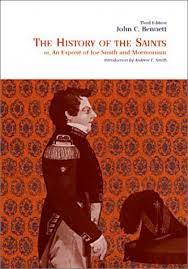Articles/Essays – Volume 33, No. 4
Protocols of the (Other) Elders of Zion | Andrew F. Smith, ed., The History of the Saints, 3d edition, by John C. Bennett
One may impute two possible rationales to the decision by the University of Illinois Press to reprint an 1842 expose of Joseph Smith and Mor monism. Its re-publication may represent an appreciation for its value as a window on anti-Mormon hysteria and hate-mongering in an era when the paranoid imagination and the literature of reprisal wrought much tragedy in Missouri and Illinois. One could also value it as an historically plausible account of early Mormon duplicity and infamy. Discounting its excesses, one might consider the book revealing and credible enough to contribute meaningfully to a fuller understanding of how Mormonism invited its own tragic chapters in American history. (The jacket offers a third rationale, one we are reluctant to take seriously. Even if Bennett is unreliable, we are told, “wherever the truth lies, The History of the Saints is a titillating concoction of indignation, revelation, and vituperation.” That it may be, but one hopes that a press of this stature does not seriously consider that a sound basis for publication.)
Andrew F. Smith, the editor, makes a case for the book’s documentary value in his lengthy introduction, but he is not very convincing. Smith reminds us that Bennett cannibalized almost four-fifths of the material from other hostile accounts. Bennett pro vides affidavits of Danite activity, evidence of Joseph’s “amours and at tempted seductions” and his theocratic aspirations, and a “mass of evidence” alleging various criminal activities (the catalogue ranges from arson and bestiality to rape and treason [257]). There is nothing new—obviously—in these charges. What is new is their presentation by a scholarly press in the context of an historical introduction that at tempts to rehabilitate Bennett’s book as good institutional, rather than cultural, history. Smith writes that Bennett has been wrongly “dismissed” by Mormon historians as either “a true believer who sadly went astray, or as an opportunist masquerading as a devout religious convert” (viii). This is curious criticism since the editor explicitly embraces the second option himself. Ben nett was a “Barnumesque” character, he writes, who always “pursued secular, not religious goals” (viii, xvii). His biography of Bennett doesn’t hedge either, as its title makes evident: The Saintly Scoundrel: The Life and Times of Dr. John Cook Bennett (University of Illinois Press, 1997). Smith’s real com plaint is that Mormon scholars have not taken this opportunist seriously as a chronicler of the prophet and church that publicly exposed and humiliated him. Smith asserts the familiar mantra that leaders of institutions generally conceal from others (and from themselves) the “real rules that govern an institution” and “the true institutional norms and ways of operating” (viii). In light of this premise, Smith apparently considers Bennett’s book valuable as primary source material for documenting—at worst—the conspiratorial machinations in early Mormon history, and—at best—the false consciousness or self-deluded motivations behind Joseph’s elaboration of early Mormon practice and belief. But with an author as prejudiced and unreliable as Bennett, who “left no infamy unclaimed in his attack on Mormonism” (xxxi), how are we to find illumination into “true institutional norms” and the “real rules” of Mormonism?
It may be merely idiosyncratic that Andrew R Smith insists—against a tide of scholarship now decades old—that the theory that Solomon Spaulding authored the Book of Mormon is entirely plausible. In the section on the Missouri persecutions, his bias becomes more disturbing. Smith refers to Joseph’s creation of the Danites “to enforce his will” and “suppress dis sent” though the extent of his control over this mysterious band remains open to debate (xv). He then refers to Sidney Ridgon’s inflammatory 4th of July speech that aroused “non-Mormon” (never “anti-Mormon”) ire, and—in what many readers may at first think a misprint—writes that the “Mormon militia plundered non-Mormon settlements” (xv). Factually correct, perhaps, but what does such a fact mean when the author neglects to mention the slaughter of Mormons at Haun’s Mill and never even hints that attacks, house burnings, mobbings, and murder took place against Mormons? Even the riot to prevent Mormons from voting at Gallatin is sanitized here as an “electoral altercation” (xv), thus preserving the editor’s narrative agenda: Mormons were the only real instigators and perpetrators of violence in Missouri. This is “history” in the same sense that Bennett’s book is a “History,” and the lack of objectivity is as transparent as it is bewildering in a university press publication.
Even accepting the legitimacy of some of Bennett’s charges about the beginnings of secret polygamy in Nauvoo and Joseph’s theocratic designs, his sheer rhetorical and sensationalistic excess led the editor James Gordon Bennett to conclude in 1842 that the book’s publication “utterly disgraces its publisher” (xxxii). Perhaps the same can’t be said of its re-publication. But justifying the decision by appealing to “titillation” will not do. And promising, in a uni-dimensional introduction, that the book will reveal Mormonism’s “real ways of operating” does not remove us as far from 19th century sensationalism as we could wish.
The History of the Saints, 3d edition, by John C. Bennett, ed. Andrew F. Smith (Urbana: University of Illinois Press, 2000), 341pp., $34.95


 Back to full Issue
Back to full Issue

